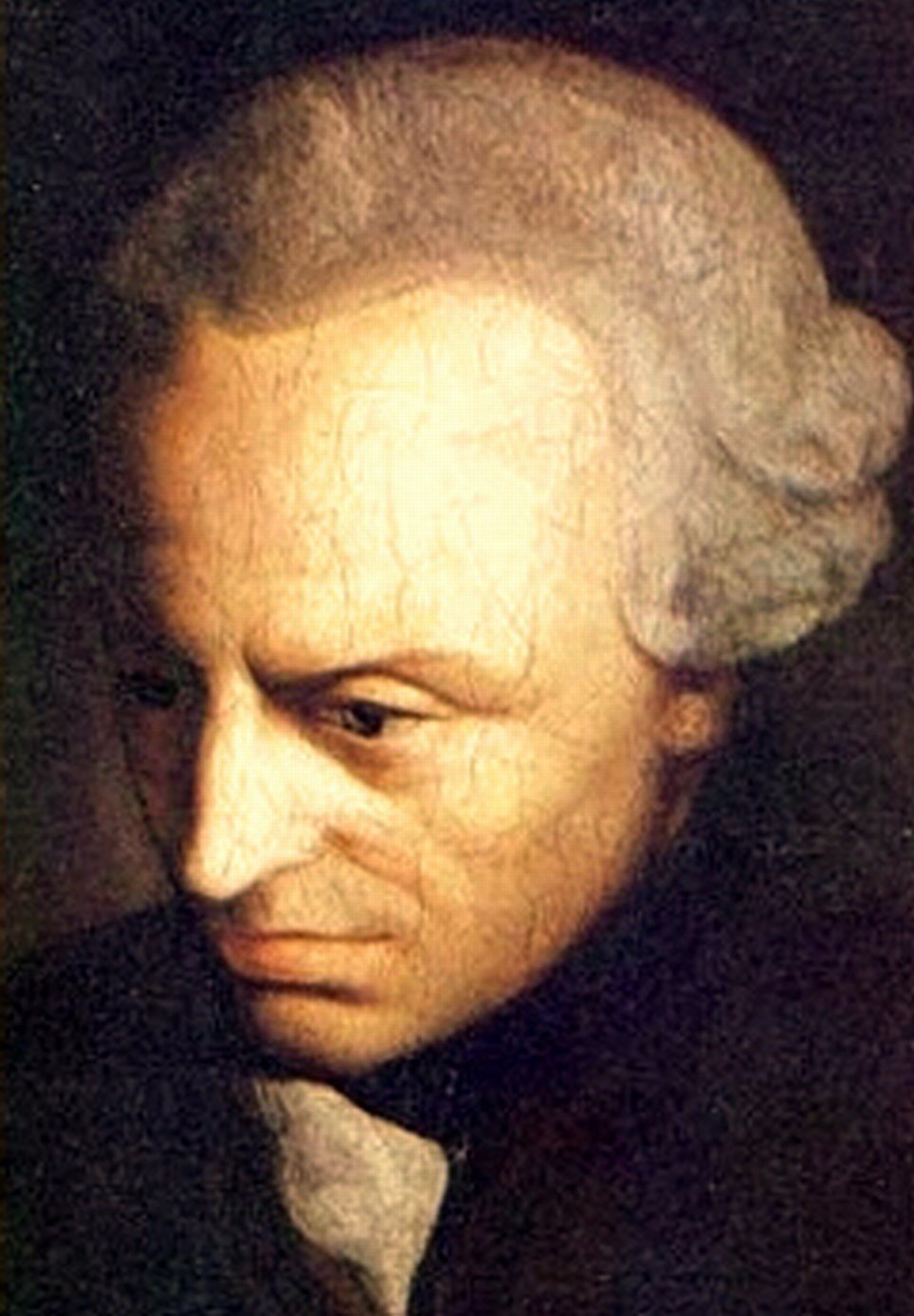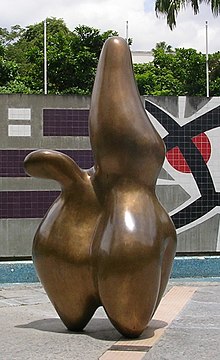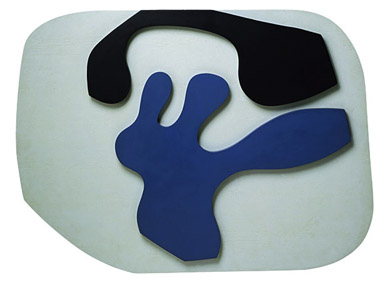_____
Immanuel Kant: The Imaginative Faculty and the Function of ArtI readily admit that I'm not able to penetrate the thicket of abstractions and syntax to achieve full comprehension of the epistemological speculations in these excerpts from The Critique of Pure Reason (1781) and The Critique of Judgment (1790). So let's start with the summary in Ellmann and Feidelson's introduction:
 |
| Immanuel Kant, date unknown |
To distinguish between nature and imagination is often only a step toward reconciling the two. This rapprochement is apparent in Kantian idealism. Kant postulates a "transcendental faculty of imagination," an a priori unifying or "synthetic" power of the mind without which we could never reproduce the image of an object (its "representation"), just as we would never have possessed any image at all without an earlier "synthesis of apprehension." In effect, Kant regards aesthetic creation (or "genius") as a special case of the generic imagination. Unlike mere "taste," which is an apprehension of nature, genius is active and constructive. It is the "beautiful representation of a thing." The world of aesthetic ideas, the products of genius, is like a second nature built out of the first, the "actual nature" that we grasp through the synthesis of apprehension, and recall through the synthesis of reproduction. The aesthetic world also differs from the nature that is known through concepts. Though both are constructs, aesthetic nature has a richness of content that no abstract rational scheme can ever encompass. Yet the aesthetic world is truly a world of thought. It has the idea quality of intellectual forms and the intuitive, untranslatable immediacy of sensory perception.Everybody clear on that now? Yeah, well, I'm getting there. At least I begin to understand the problem: How do we know the world outside of us, and how do we distinguish that "real" world from things we imagine? And then, what is the role of art in relation to these things?
 |
| Cinnabar |
If cinnabar were sometimes red and sometimes black, sometimes light and sometimes heavy, if a man could be changed now into this, now into another animal shape, if on the longest day the fields were sometimes covered with fruit, sometimes with ice and snow, the faculty of my empirical imagination would never be in a position, when representing red colour, to think of heavy cinnabar.But thanks to the "synthesis of apprehension," we hold all the various attributes of an object together in the mind, and we can isolate any given characteristic, such as redness, to evoke the whole. Moreover, the coherence of attributes suggests that "There must therefore be something to make this reproduction of phenomena possible" -- that is, something out there, outside the mind, that is "the foundation a priori of a necessary synthetical unity." So the imagination works with these external materials -- otherwise experience itself would be impossible. "The synthesis of apprehension is therefore inseparably connected with the synthesis of reproduction.... We may therefore call this faculty the transcendental faculty of imagination."
Kant's distinction of taste from genius is similarly difficult to swim through, but the premise is clearly enough stated: "For estimating beautiful objects, as such, what is required is taste; but for fine art, i.e., the production of such objects, one needs genius." The distinction between Art and Nature, so central to modern ideas about both, is stated thus by Kant: "A beauty of nature is a beautiful thing; beauty of art is a beautiful representation of a thing." It should go without saying by now that Kant doesn't use words like taste and genius and beauty (or rather the German equivalents of these words) in our conventional senses, which tends to muddle our understanding of what he's getting at, especially when he tries to use examples: "where one says, for example, 'that is a beautiful woman,' what one in fact thinks is only this, that in her form nature excellently portrays the ends present in the female figure." I hope that clears things up for you; for me, not so much. He adds: "For one has to extend one's view beyond the mere form to a concept, to enable the object to be thought in such a manner by means of an aesthetic judgement logically conditioned." Okay, I give up.
But this is somewhat clearer, and more to the point of our investigation of the relationship between art and nature: "Where fine art evidences its superiority is in the beautiful descriptions it gives of things that in nature would be ugly or displeasing." Kant's examples are rather too vague, but let me suggest one of my own:
 |
| Rembrandt van Rijn, The Flayed Ox, 1655 |
Taste is ... merely a critical, not a productive faculty; and what conforms to it is not, merely on that account, a work of fine art.... So we demand that table appointments, or even a moral dissertation, and, indeed, a sermon, must bear this form of fine art, yet without its appearing studied. But one would not call them on this account works of fine art. A poem, a musical composition, a picture-gallery, and so forth, would, however, be placed under this head; and so in a would-be work of fine art we may frequently recognize genius without taste, and in another taste without genius.Of some works of art, Kant observes, "we say they are soulless; and this, although we find nothing to censure in them as far as taste goes. A poem may be very pretty and elegant, but is soulless." We mean by this, Kant asserts, that it lacks "the animating principle in the mind."
Now my proposition is that this principle is nothing else than the faculty of presenting aesthetic ideas. But, by an aesthetic idea I mean that representation of the imagination which induces much though, yet without the possibility of any definite thought whatever, i.e. concept, being adequate to it, and which language, consequently, can never get quite on level terms with or render completely intelligible.I'm reminded here of Keats's embracing of uncertainty that he called "negative capability." It is also, in Kant's way of thinking, that which makes a work of art greater than any attempt to understand or describe or paraphrase its effect on us. (A lot of people today use the word "soul" in this way without ever even having heard of Kant.)
Kant also succeeds, I think, in defining that slippery word "imagination": "The imagination (as a productive faculty of cognition) is a powerful agent for creating, as it were, a second nature out of the material supplied to it by actual nature." Notice here the lack of hierarchy in the use of the terms "actual nature" and "second nature." Wilde might have elevated "second nature" (Art) over "actual nature" (Nature). But then later Kant does too: Through the imagination "material can be borrowed by us from nature ... but be worked up by us into something else -- namely, what surpasses nature." These products of the imagination -- which, he says, "may be termed ideas" -- "at least strain after something lying out beyond the confines of experience" and the concepts they present have "the semblance of an objective reality." The products of the imagination are bodied "forth to sense with a completeness of which nature affords no parallel."
Samuel Taylor Coleridge: The Coalescence of Mind and Nature
 |
| Coleridge in 1814 |
Coleridge ... pictures art as an interaction or "coalescence" of mind and nature, a process in which the original terms are altered. Imagination is not a mere duplication of nature, nor is it a propounding of human thought; it is an activity or function that lies between, a union and reconcilement of nature with what is distinctively human. By means of this vital force, which "dissolves, diffuses, dissipates in order to re-create," man joins his mind (itself responsive to laws of nature) to the spirit of nature, and both are symbolically articulated in the form of the highest art. Since it is genuinely creative, imagination is quite distinct from "fancy," which does no more than shuffle the "fixities and definites" of practical experience. In the same way, Coleridge sharply distinguishes between allegorical art, which constructs a parallel between imagination and nature, and symbolical art, which makes one tune out of two."All knowledge," Coleridge asserts, "rests on the coincidence of an object with a subject." What we have here is essentially a dialectic of mind and nature. This takes us back to the controversy surrounding the Berkeleyan premise, "esse est percipi" -- to be is to be perceived. If the object exists independently of the subject, "This desk, for instance would (according to our natural notions) be, though there should exist no sentient being to look at it." Thus "the natural philosopher ... avoids above all things the intermixture of the subjective in his knowledge," striving to acknowledge "things as they are." (See Wallace Stevens's "The Man With the Blue Guitar" for more on this aim.) But Descartes, by doubting all things, revealed that the one certitude was the existence of the subject.
The mediator between object and subject is the imagination, which Coleridge divides into primary and secondary;. "The primary Imagination I hold to be the living power and prime agent of all human perception, and as a repetition in the finite mind of the eternal act of creation in the infinite I AM." The secondary Imagination "dissolves, diffuses, dissipates, in order to recreate.... It is essentially vital, even as all objects (as objects) are essentially fixed and dead." That is, nothing outside the mind has any significant existence until the imagination shapes it and gives it significance. Fancy, on the other hand, "is a mode of memory emancipated from the order of time and space." Where Imagination is a mode of knowing, Fancy is mere play.
Under these terms, "Art, used collectively for painting, sculpture, architecture, and music, is the mediatress between, and reconciler of, nature and man. It is, therefore, the power of humanizing nature, of infusing the thoughts and passions of man into every thing which is the object of his contemplation: colour, form, motion, and sound, are the elements which it combines, and it stamps them into unity in the mould of a moral idea." For Coleridge, naturally, "The primary art is writing," which is "a translation of man into nature, ... a substitution of the visible for the audible." Poetry's "materials are from the mind, and all its products are for the mind ... and thus it elevates the mind by making its feelings the object of its reflexion." Poetry "avails itself of the forms of nature to recall, to express, and to modify the thoughts and feelings of the mind."
Nature "is to a religious observer the art of God," and by this token, "art itself might be defined as ... the union and reconciliation of that which is nature with that which is exclusively human." So does art imitate nature? Coleridge suggests that "in all imitation two elements must coexist, and not only coexist, but must be perceived as coexisting." The elements that must coexist are "likeness and unlikeness, or sameness and difference, and in all genuine creations of art there must be a union of these disparates." If the work of art is too much like its correspondent in nature, it fails: "Why are such simulations of nature, as waxwork figures of men and women, so disagreeable? Because, not finding the motion and life which we expected, we are shocked as by a falsehood.... You set out with a supposed reality and are disappointed and disgusted with the deception."
So if the artist imitates nature, he or she should strive for nature in process (natura naturans) rather than for faithfulness to the external forms of nature (natura naturata);
If the artist copies the mere nature, the natura naturata, what idle rivalry! If he proceeds only from a given form, which is supposed to answer to the notion of beauty, what an emptiness, what an unreality there always is in his productions.... Believe me, you must master the essence, the natura naturans, which presupposes a bond between nature in the higher sense and the soul of man.This is pretty much what Kant was getting at in his discourse on "soul" in art. Coleridge is, however, not much better at pinpointing exactly what it means to "master the essence," but he makes a stab at it: "to make the external internal, the internal external, to make nature thought, and thought nature, -- this is the mystery of genius in the Fine Arts." I'm not sure we're much further along, however. He continues: "The artist must imitate that which is within the thing, that which is active through form and figure, and discourses to us by symbols -- the Natur-geist, or spirit of nature.... Hence a good portrait is the abstract of the personal; it is not the likeness for actual comparison, but for recollection. This explains why the likeness of a very good portrait is not always recognized." Remember Picasso's comments on the portraits of Philip IV by Velasquez and Van Rubens?
And there's that word "symbol," which is what we're supposedly dealing with here. For Coleridge, "a symbol ... is characterized by a translucence of the special in the individual, or of the general in the special or of the universal in the general; above all by the translucence of the eternal through and in the temporal. It always partakes of the reality which it renders intelligible; and while it enunciates the whole, abides itself as a living part in that unity of which it is the representative."
Rainer Maria Rilke: The Penetration of Things
In another letter to "Merline," Rilke speaks of the kind of intimacy that artists must feel with things external to themselves in order to incorporate them into their work.
If a thing is to speak to you, you must regard it for a certain time as the only one that exists, as the one and only phenomenon, which, thanks to your laborious and exclusive love, is now placed at the center of the Universe, and there, in that incomparable place, is this day attended by the Angels.
 |
| Baladine Klassowska's portrait of Rilke, 1922 |
Hans Arp: Concrete Art
 |
| Hans Arp, 1926 |
He wanted immediate and direct production, like a stone breaking away from a cliff, a bud bursting, an animal reproducing. He wanted objects impregnated with imagination and not museum pieces, he wanted animalesque objects with wild intensities and colors, he wanted a new body among us which would suffice unto itself, an object which would be just as well off squatting on the corners of tables as nestling in the depths of the garden, or staring at us from the wall.Even as a child, Arp claims, he mocked what he calls the "useless crutches" on which art depends: the pedestal and the frame. "Sometimes I took our pictures out of their frames and looked with pleasure at these windows hanging on the wall. Another time I hung up a frame in a little wooden shack, and sawed a hole in the wall, behind the frame, disclosing a charming landscape animated by men and cattle." The aim of Dada, he says, was to be "senseless like nature."
 |
| Hans Arp, Cloud Shepherd, 1953 |
This extended to a contempt for categories and absolutes: "Man declares red what he called green the day before and what in reality is black." Above all, the aim of Dada was to puncture human vanity: "Since the days of the caves, man has glorified and deified himself, and has brought about human catastrophe by his monstrous vanity."
But few things exasperated Arp more than the notion that art is an abstraction of nature. For Arp, art is a thing in itself, "a fruit that grows in man, like a fruit on a plant, or a child in its mother's womb.... I believe that nature is not in opposition to art. Art is of natural origin and is sublimated and spiritualized through the sublimation of man." Those who consider art a representation of nature love "what is vain or dead."
Arp asserts that "the human mind underwent a transformation about the year 1914." (Virginia Woolf put it a few years earlier: December 1910, to be exact.) The outbreak of World War I called into question the values that had persisted, Arp says, since "the renaissance puffed up human reason with pride. modern times with their science and technology have made man a megalomaniac. the atrocious confusion of our epoch is the consequence of this overestimation of reason." Hence the manifesto of concreteness:
Hans Arp, Turned Blue Shoe With Two Heels Beneath Black Volt, 1925 we do not want to copy nature. we do not want to reproduce. we want to produce like a plant that produces a fruit and not to reproduce. we want to produce directly and not through interpretation.
as there is not the slightest trace of abstraction in this art, we call it: concrete art....concrete art aims to transform the world. it aims to make existence more bearable.... concrete art is an elemental, natural, healthy art, which causes the stars of peace, love and poetry to grow in the head and the heart, where concrete art enters, melancholy departs, dragging with it its gray suitcases full of black sighs.


No comments:
Post a Comment